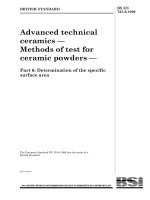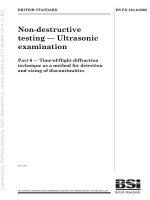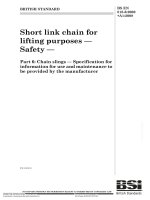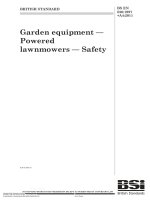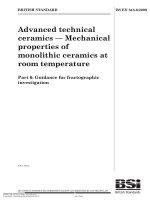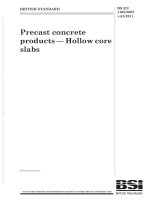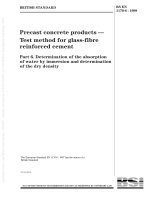Bsi bs en 61747 6 3 2011
Bạn đang xem bản rút gọn của tài liệu. Xem và tải ngay bản đầy đủ của tài liệu tại đây (1.62 MB, 28 trang )
BS EN 61747-6-3:2011
BSI Standards Publication
Liquid crystal display
devices
Part 6-3: Measuring methods for liquid
crystal display modules — Motion artifact
measurement of active matrix liquid
crystal display modules
NO COPYING WITHOUT BSI PERMISSION EXCEPT AS PERMITTED BY COPYRIGHT LAW
raising standards worldwide™
BRITISH STANDARD
BS EN 61747-6-3:2011
National foreword
This British Standard is the UK implementation of EN 61747-6-3:2011. It is
identical to IEC 61747-6-3:2011.
The UK participation in its preparation was entrusted to Technical Committee
EPL/47, Semiconductors.
A list of organizations represented on this committee can be obtained on
request to its secretary.
This publication does not purport to include all the necessary provisions of a
contract. Users are responsible for its correct application.
© BSI 2011
ISBN 978 0 580 60028 9
ICS 31.120
Compliance with a British Standard cannot confer immunity
from legal obligations.
This British Standard was published under the authority of the
Standards Policy and Strategy Committee on 30 September 2011.
Amendments issued since publication
Amd. No.
Date
Text affected
BS EN 61747-6-3:2011
EUROPEAN STANDARD
EN 61747-6-3
NORME EUROPÉENNE
September 2011
EUROPÄISCHE NORM
ICS 31.120
English version
Liquid crystal display devices Part 6-3: Measuring methods for liquid crystal display modules Motion artifact measurement of active matrix liquid
crystal display modules
(IEC 61747-6-3:2011)
Dispositifs d'affichage à cristaux liquides Partie 6-3: Méthodes de mesure pour les
modules d'affichage à cristaux liquides Mesure de l'artefact de mouvement dans
les modules d'affichage à cristaux liquides
à matrice active
(CEI 61747-6-3:2011)
Flüssigkristall-Anzeige-Bauelemente Teil 6-3: Messverfahren für
Bewegungsartefakte bei Aktiv-MatrixLCD-Modulen
(IEC 61747-6-3:2011)
This European Standard was approved by CENELEC on 2011-08-17. CENELEC members are bound to comply
with the CEN/CENELEC Internal Regulations which stipulate the conditions for giving this European Standard
the status of a national standard without any alteration.
Up-to-date lists and bibliographical references concerning such national standards may be obtained on
application to the Central Secretariat or to any CENELEC member.
This European Standard exists in three official versions (English, French, German). A version in any other
language made by translation under the responsibility of a CENELEC member into its own language and notified
to the Central Secretariat has the same status as the official versions.
CENELEC members are the national electrotechnical committees of Austria, Belgium, Bulgaria, Croatia, Cyprus,
the Czech Republic, Denmark, Estonia, Finland, France, Germany, Greece, Hungary, Iceland, Ireland, Italy,
Latvia, Lithuania, Luxembourg, Malta, the Netherlands, Norway, Poland, Portugal, Romania, Slovakia, Slovenia,
Spain, Sweden, Switzerland and the United Kingdom.
CENELEC
European Committee for Electrotechnical Standardization
Comité Européen de Normalisation Electrotechnique
Europäisches Komitee für Elektrotechnische Normung
Management Centre: Avenue Marnix 17, B - 1000 Brussels
© 2011 CENELEC -
All rights of exploitation in any form and by any means reserved worldwide for CENELEC members.
Ref. No. EN 61747-6-3:2011 E
BS EN 61747-6-3:2011
EN 61747-6-3:2011
Foreword
The text of document 110/296/FDIS, future edition 1 of IEC 61747-6-3, prepared by IEC TC 110, Flat
panel display devices, was submitted to the IEC-CENELEC parallel vote and approved by CENELEC as
EN 61747-6-3:2011.
The following dates are fixed:
•
•
latest date by which the document has
to be implemented at national level by
publication of an identical national
standard or by endorsement
latest date by which the national
standards conflicting with the
document have to be withdrawn
(dop)
2012-05-17
(dow)
2014-08-17
Attention is drawn to the possibility that some of the elements of this document may be the subject of
patent rights. CENELEC [and/or CEN] shall not be held responsible for identifying any or all such patent
rights.
Endorsement notice
The text of the International Standard IEC 61747-6-3:2011 was approved by CENELEC as a European
Standard without any modification.
In the official version, for Bibliography, the following notes have to be added for the standards indicated:
IEC 61747-1:2003
NOTE Harmonized as EN 61747-1:1999 + A1:2003 (not modified).
IEC 61747-5:1998
NOTE Harmonized as EN 61747-5:1998 (not modified).
ISO 9241-307
NOTE Harmonized as EN ISO 9241-307.
ISO 11664-4:2008
NOTE Harmonized as EN ISO 11664-4:2011 (not modified).
BS EN 61747-6-3:2011
EN 61747-6-3:2011
Annex ZA
(normative)
Normative references to international publications
with their corresponding European publications
The following referenced documents are indispensable for the application of this document. For dated
references, only the edition cited applies. For undated references, the latest edition of the referenced
document (including any amendments) applies.
NOTE When an international publication has been modified by common modifications, indicated by (mod), the relevant EN/HD
applies.
Publication
Year
Title
EN/HD
IEC 61747-6
-
Liquid crystal and solid-state display devices - EN 61747-6
Part 6: Measuring methods for liquid crystal
modules - Transmissive type
Year
-
BS EN 61747-6-3:2011
61747-6-3 IEC:2011
CONTENTS
1
Scope . ............................................................................................................................................. 6
2
Normative references . .................................................................................................................. 6
3
Terms and definitions . .................................................................................................................. 6
4
Abbreviations ................................................................................................................................. 7
5
Standard measuring conditions . .................................................................................................. 7
5.1
5.2
6
Standard motion-blur measuring methods . ................................................................................ 8
6.1
6.2
6.3
7
Temperature, humidity and pressure conditions . ............................................................ 7
Illumination condition . ......................................................................................................... 7
General ................................................................................................................................. 8
Direct measurement method . ............................................................................................. 8
6.2.1 Standard measuring process . .............................................................................. 8
6.2.2 Test patterns . ......................................................................................................... 8
6.2.3 Analysis method . ................................................................................................. 10
Indirect measurement method . ....................................................................................... 12
6.3.1 Temporal step response . .................................................................................... 12
6.3.2 High speed camera . ............................................................................................. 15
Test report. ................................................................................................................................... 16
7.1
7.2
General . ............................................................................................................................. 16
Items to be reported . ........................................................................................................ 16
7.2.1 Environmental conditions .................................................................................... 16
7.2.2 Display parameters . ............................................................................................. 16
7.2.3 Measuring method and conditions . ................................................................... 16
7.2.4 Analysis method . ................................................................................................. 16
Annex A (informative) Subjective test method . ............................................................................. 18
Annex B (informative) Motion contrast degradation . .................................................................... 19
Annex C (informative) Dynamic modulation transfer function . .................................................... 21
Bibliography ......................................................................................................................................... 23
Figure 1 – Examples of edge blur test pattern . ................................................................................ 8
Figure 2 – Example of a pivoting pursuit camera system . .............................................................. 9
Figure 3 – Example of a linear pursuit camera system . .................................................................. 9
Figure 4 – Example of luminance cross section profile of blurred edge . ................................... 11
Figure 5 – Example of luminance cross section profile of blurred edge . ................................... 11
Figure 6 – PBET calculation .............................................................................................................. 12
Figure 7 – Set-up to measure the temporal step response . ......................................................... 13
Figure 8 – Example of a LC response time measurement . ........................................................... 14
Figure 9 – Example of a motion picture response curve derived from the response
measurement presented in Figure 8, and a convolution with a one frame wide window
function................................................................................................................................................. 15
Figure 10 – Example of measurement data reporting . .................................................................. 17
Figure B.1 – Example of motion contrast degradation test pattern . ............................................ 19
Figure B.2 – Example of motion contrast degradation due to line spreading . ........................... 20
Figure C.1 – Example of motion contrast degradation .................................................................. 21
BS EN 61747-6-3:2011
61747-6-3 IEC:2011
Figure C.2 – Example of DMTF properties for different motion speeds (V) ............................... 22
Table 1 – Step response data for different luminance transitions . ............................................. 10
–6–
BS EN 61747-6-3:2011
61747-6-3 IEC:2011
LIQUID CRYSTAL DISPLAY DEVICES –
Part 6-3: Measuring methods for liquid crystal display modules –
Motion artifact measurement of
active matrix liquid crystal display modules
1
Scope
This part of IEC 61747 applies to transmissive type active matrix liquid crystal displays.
This standard defines general procedures for quality assessment related to the motion
performance of LCDs. It defines artifacts in the motion contents and methods for motion
artifact measurement.
NOTE Motion blur measurement methods and analysis methods introduced in this standard could not be universal
tools for all different LCD motion enhancement technologies due to its complexity. Users shall be notified of these
circumstances.
2
Normative references
The following referenced documents are indispensable for the application of this document.
For dated references, only the edition cited applies. For undated references, the latest edition
of the referenced document (including any amendments) applies.
IEC 61747-6, Liquid crystal and solid-state display devices – Part 6: Measuring methods for
liquid crystal modules – Transmissive type
3
Terms and definitions
For the purposes of this document, the following terms and definitions apply.
3.1
motion picture response curve
a curve, representing the convolution of the temporal step response with a moving window
function of 1-frame wide. It shows how the luminance is integrated over time during smooth
pursuit eye tracking and combines the effects of the LCD response time and the hold-type
characteristics of the device under test
3.2
motion induced edge profile
luminance profile of an intrinsically sharp moving luminance transition when this transition is
followed with smooth pursuit eye tracking along its motion trajectory
NOTE
The profile can be calculated from the motion picture response curve for any given motion speed.
3.3
edge blur
blur that becomes visible on an intrinsically sharp transition between two adjacent areas, with
a different luminance level, when the transition smoothly moves across the display as a
function of time.
NOTE Preconditions for this type of edge blur are smooth pursuit eye tracking of the object, and no obvious
flicker, indicating that luminance integration with a frame period is allowed. This blur phenomenon is mainly caused
by a slow response time of the liquid crystal cell in combination with the hold-type characteristics.
BS EN 61747-6-3:2011
61747-6-3 IEC:2011
–7–
3.4
perceived blurred edge time
time-related equivalent of the perceived blurred edge width. The latter one is derived from the
motion induced edge profile by means of filtering the edge profile with the contrast sensitivity
function of the human eye
4
Abbreviations
For the purpose of this document, the following abbreviations apply.
5
5.1
BET
blurred edge time
BEW
blurred edge width
CCD
charge-coupled device
CIE
Commission
illumination)
CMOS
complimentary metal-oxide semiconductor
CSF
contrast sensitivity function
DMTF
dynamic modulation transfer function
DUT
display under test
DVI
digital visual interface
EBET
extended blurred edge time
FFT
fast Fourier transform
IEC
International Electrotechnical Commission
ISO
International Organization for Standardization
JND
just noticeable difference
LCD
liquid crystal display
LMD
light measuring device
LVDS
low-voltage differential signaling
MCD
motion contrast degradation
MPRC
motion picture response curve
MTF
modulation transfer function
PBET
perceived blurred edge time
PBEW
perceived blurred edge width
TN-LCD
twisted nematic liquid crystal display
VA-LCD
vertically-aligned liquid crystal display
Internationale
de
l’Eclairage
(international
commission
on
Standard measuring conditions
Temperature, humidity and pressure conditions
The standard environmental condition for the motion artifact measurement is (25 ± 3) °C for
temperature, 25 % to 85 % for relative humidity, and 86kPa to 106kPa for air pressure. All
visual inspection tests shall be tested in (25 ± 5) °C.
5.2
Illumination condition
The illuminance at the measuring spot of the DUT shall be below 1 lx (standard dark room
condition as defined in IEC 61747-6).
–8–
6
BS EN 61747-6-3:2011
61747-6-3 IEC:2011
Standard motion-blur measuring methods
6.1
General
Motion induced object blur is the result of a slow response of the liquid crystal cells and a
stationary representation of the temporal image (related to the hold time of the display), in
combination with smooth pursuit eye-tracking of an object over the display surface. When an
object moves across the display and the eye is tracking this object, a spatiotemporal
integration of the object luminance is taken place at the human retina. There are several ways
to measure and characterize this spatiotemporal integration, via a direct measurement or via
an indirect measurement technique. For direct measurements a pursuit camera system can be
used, and the indirect measurement is based on measuring the temporal response curves and
from those curves the motion induced object blur that will occur on the retina can be
calculated. Both direct and indirect measurements will be described in this standard.
6.2
Direct measurement method
6.2.1
Standard measuring process
6.2.2
Test patterns
There are several patterns that can be used to measure motion induced object blur, such as
full test pattern, box test pattern, and line bar test pattern (see Figure 1). The details of the
used test pattern(s) shall be reported. When using a pursuit system, the width of the test
pattern should be sufficiently wide, e.g. 5 time the advancement (step-width) per frame, to
capture the total temporal response of the display. It is recommended that a minimum of
seven gray shades, including black and white, are used for gray level of each part of a test
pattern in Figure 1. The lightness function, specified in CIE 1976 (L*u*v*) and CIE 1976
(L*a*b*) color spaces, can be used to space the intermediate gray shades equally on the
lightness scale. One of gray level data that are available at the LCD modules input, e.g. 0 to
255 for an 8-bit LCD module, also can be used as this gray level.
(A) Full test pattern
(B) Box test pattern
(C) Line bar test pattern
IEC 1605/11
Figure 1 – Examples of edge blur test pattern
6.2.2.1
Pursuit detection system
Measuring edge blur of the LCD module should be done by using CCD camera with the
pursuit measurement system shown in Figure 2 and Figure 3. Relevant literature on these
systems can be found in the bibliography, references [1] 1 to [5].
___________
1
Figures in square brackets refer to the Bibliography.
BS EN 61747-6-3:2011
61747-6-3 IEC:2011
–9–
Pursuing speed (v)
Moving pattern
scroll speed (v)
LMD with pursuing system
Captured image on CCD
IEC 1606/11
Figure 2 – Example of a pivoting pursuit camera system
LCD module
Moving test pattern
Linear pursuing LMD system
Captured image
IEC 1607/11
Figure 3 – Example of a linear pursuit camera system
The following guidelines are recommended when implementing the pursuit measuring system:
a) LMD: CCD or CMOS type surface measurement devices (CCD camera), with preferably an
integrated CIE 1931 photopic luminous sensitivity function (measuring luminance).
b) Scroll speed: the scroll speed of test pattern and the pursuing speed of LMD shall be
synchronized accurately to prevent integration errors.
c) Pursuing system: either pivoting or linear pursuit system shown in Figure 2 and Figure 3,
respectively. The angular rotation shall be limited to avoid viewing-angle related
dependencies (less than ±5˚).
BS EN 61747-6-3:2011
61747-6-3 IEC:2011
– 10 –
6.2.2.2
a)
Specified conditions
Any deviations from the standard measurement conditions shall be reported: “Full test
pattern” shown in Figure 1(A) shall be used as the test pattern for this test method. Other
test patterns, such as “Box test pattern” shown in Figure 1(B) or “Line bar test pattern”
shown in Figure 1(C), can be used additionally depending on the requirements. The used
patterns shall be reported.
NOTE When other test patterns other than the standard “Full test pattern” are used, special care should be taken
because the size of the pattern can alter the luminance level of some of the LCD modules equipped with automatic
luminance level control function, or some long tails of the blurred edge can fall on the adjacent edge causing
ambiguity in the data analysis.
b)
The signal level (the start level and the end level) for the test pattern is summarized Table
1.
Table 1 – Step response data for different luminance transitions
Start level
Data per color
(e.g. R,G,B,W)
L1
L2
L3
..
..
LN
c)
L1
L 2-1 (t)
L 3-1 (t)
L N-1 (t)
L2
L 1-2 (t)
L 3-2 (t)
L N-2 (t)
End level
L3
..
L 1-3 (t)
L 2-3 (t)
..
LN
L 1-N (t)
L 2-N (t)
L 3-N (t)
L N-3 (t)
Standard measuring conditions
1)
Scroll speed : 4, 8, 12 pixel/frame
2)
Shutter speed of camera : 1/20 sec.
6.2.3
6.2.3.1
Analysis method
Blurred edge time
The time between the transition from 10 % to 90 % in the luminance transition curve (see
Figure 4) is used to represent blurred edge time. Other ranges, such as 40 % to 60 %, can be
used, but they shall be reported.
BS EN 61747-6-3:2011
61747-6-3 IEC:2011
– 11 –
Luminance transition curve
1,4
Relative luminance intensity
1,2
1,0
90 %
0,8
0,6
0,4
0,2
0
10 %
0
5
10
15
20
25
Time (ms)
30
35
40
45
50
IEC 1608/11
Figure 4 – Example of luminance cross section profile of blurred edge
6.2.3.2
Extended blurred edge time
The extended blurred edge time is defined as EBET = BET/0.8, which linearly extends the
BET to the 0 % to 100 % levels (see Figure 5).
Luminance transition curve
1,4
Relative luminance intensity
1,2
100 %
1,0
90 %
0,8
0,6
0 % - 100 %
0,4
0,2
10 %
0%
0
0
5
10
15
20
25
Time (ms)
30
35
40
45
50
IEC 1609/11
Figure 5 – Example of luminance cross-section profile of blurred edge
6.2.3.3
Perceived blurred edge time
The process to obtain a PBET curve is described in bibliographic reference [6], and
summarized in Figure 6. Luminance blurred edge is converted to a spectrum by a fast Fourier
transformation (FFT). The spectrum is multiplied by values given by CSF. After then a PBET
BS EN 61747-6-3:2011
61747-6-3 IEC:2011
– 12 –
curve is obtained by an inverse FFT. The value of the PBET is the distance between the
peaks of PBET curve (expressed in ms).
Fourier
transform
Spatial
frequency
Spatial
frequency
Inverse
Fourier
transform
PBET
Relative stimuli
Sensitivity
Relative luminance
CCD pixel
PBEW
Relative stimuli
CSF
Luminance profile
Transform
Width
Time
IEC 1610/11
Figure 6 – PBET calculation
NOTE
This standard recommends Peter Barten’s CSF (reference [7]), although other CSFs could be used.
Barten’s CSF formulae:
S (u ) =
1
=
mt (u )
e −2π
2
σ 2u 2
2 1
1
u2
+
+
2
2
T X 02 X max
N max
/k
1
Φ0
+
2
ηpE
1 − e − (u / u0 )
where
S(u)
is the spatial contrast sensitivity function for binocular vision;
m t (u)
is the modulation threshold;
u
is the spatial frequency;
σ
is the standard deviation of the line-spread function of the eye ;
K
is the signal-to-noise ratio (3,0);
T
is the integration time of the eye (0,1 s);
XO
is the angular size of the object;
X max
is the maximum angular filed size of the object (12˚);
N max
is the maximum number of cycles over which the eye can integrate (15 cycles);
η
is the quantum efficiency of the eye (0,03);
p
is the photon conversion factor, depending on the light source
6
(e.g. 1,2 10 photons/sec/deg2/Td) ;
E
is the retinal illumination (Td);
Φ0
is the spectral density of the neural noise (3,10
Uo
is the spatial
cycles/degree).
frequency
above
which
-8
2
sec deg );
the
lateral
inhibition
ceases
(7
For the calculations, the viewing distance is set to 1.5 times the diagonal screen size of the
active display area (approximately 3 x height of display active area)
6.3
6.3.1
Indirect measurement method
Temporal step response
The temporal step response measurement method is based on the literature, indicated in the
Bibliography, i.e., references [9] to [15].
BS EN 61747-6-3:2011
61747-6-3 IEC:2011
6.3.1.1
– 13 –
Measurement system
A schematic representation of the measurement set-up to measure the temporal step
response is shown in Figure 7.
1) DUT
v(t)
4) Amplifier
3) Photo
diode
LVDS/DVI
5) Data
acquisition
Trigger
2) Pattern
generator
Data transfer
Control
6) Luminance
meter
Monitor
7) Control
system
L,x,y transfer
IEC 1611/11
Figure 7 – Set-up to measure the temporal step response
The measurement set-up, presented in Figure 7, comprises of the following components:
The DUT (1), which is the display to be measured.
A pattern generator (2), which generates the test patterns in the native display resolution and
applicable refresh rates. The pattern generator, preferably, has a control terminal or interface,
which enables selection of the pattern and start-stop of the measurement procedure. The
output of the pattern generator may consist of one or more LVDS, DVI, or other output
terminal(s), which can be connected with the display input terminal(s). The pattern generator
should also include a trigger output signal that can be used to start the data acquisition
process.
A fast response photo-diode or other opto-electrical detector (3), with a spectral sensitivity
that is matched to the spectral luminous efficiency function V( λ ) for photopic vision. This
detector is used to capture the temporal luminance, produced by the DUT.
A signal amplifier (4), which is used for signal amplification to match the input range of data
acquisition device, and for low-pass filtering to attenuate the signal noise.
A data acquisition device (5) that records the amplified signal v(t) of the photo-diode. The
sampling rate shall be at least 10 kHz to enable acquiring temporal luminance data with
sufficient temporal resolution, and furthermore the sampling rate should be related to the
refresh rate of the display to allow time accurate analysis of the data. An oscilloscope or a
data-acquisition card can be used to acquire and digitize the time-varying luminance signal.
A luminance meter (6) that records the luminance of the display for each input code (0 to 255
for an 8-bit input signal). With this information the time varying photo-diode signal v(t) can be
translated to a time varying luminance signal L(t) = f(v(t)).
A control system (7), e.g. a personal computer, which can be used to start the measurement
procedure, and to collect and process all data.
BS EN 61747-6-3:2011
61747-6-3 IEC:2011
– 14 –
6.3.1.2
Measurement process
In liquid crystal displays the temporal luminance transition from one level to another depends
on the selected input codes. The time required for the transition to be completed has an
influence on the perceived motion blur, and therefore several luminance transitions need to be
measured. The number of luminance transition levels should be at least seven, and they
should be spaced equidistant on the CIE1976 lightness scale. In order to determine the
appropriate luminance levels, first the luminance transfer function of the DUT should be
measured.
The pattern generator should generate images with grey-level values ranging from 0 to 255
(for an 8-bit display), and the corresponding luminance levels should be measured with the
luminance meter. At about the same screen position, the photo-diode (3) signal should be
measured in parallel to enable conversion from the time-varying voltage values to luminance
values. Next the (seven) luminance levels will be used as start and end levels to measure the
temporal step responses of the DUT. In this case the pattern generator will generate the
luminance transitions, which will be recorded with the data acquisition device (5) via the
photo-diode, amplifier combination.
Multiple traces can be acquired with the control system (7) to enable temporal averaging of
the step responses. Furthermore, to assure accurate and stable start- and end-levels, the
step response should comprise of six frames with the start-level and at least six frames with
the end-level. Of course it is also possible and allowed to record the rising and falling
luminance transitions in one pass. The measurements can be summarized with the following
table, where each cell in the table consists of an array with the temporal luminance data. To
enable analyzing motion related color artifacts, tables are required for each primary color as
well as for white (see Table 1).
6.3.1.3
6.3.1.3.1
Data analysis
Motion picture response curve
From the temporal step response, the motion picture response curve shall be calculated for
each transition and each primary color. This is done with a simple convolution of the step
response with a moving window function of 1-frametime wide (see for instance [12]). An
example of the convolution process is depicted in Figure 8, and the result is depicted in
Figure 9.
LC response time and window function: transition 0 -> 255 -> 0
Normalized luminance
1
0,8
0,6
0,4
0,2
0
0
0,05
0,1
Time (s)
0,15
0,2
0,25
IEC 1612/11
Figure 8 – Example of a LC response time measurement
BS EN 61747-6-3:2011
61747-6-3 IEC:2011
– 15 –
MPRC: transition 0 -> 255 -> 0
Normalized luminance
1
0,8
0,6
0,4
0,2
0
0
0,05
0,1
0,15
Time (s)
0,2
0,25
IEC 1613/11
Figure 9 – Example of a motion picture response curve
derived from the response measurement presented in Figure 8,
and a convolution with a one frame wide window function
6.3.1.3.2
Motion Induced edge profile
From the motion picture response curves, the edge profiles can be derived for any given
object speed. First the motion picture response curves shall be converted from the temporal
to the spatial domain with using the relation x r = -ν. τ / T f , in which x r is the position of the
display pixel, projected on the retina, τ is time, T f is the frame time, and ν is the motion speed
expressed in pixels per frame (the minus sign indicates motion from left to right). For each
luminance transition, the edge blur profile linearly scales with the motion speed. The higher
the motion speed the less pronounced the luminance transition of the edge will be. The
visibility of the edge blur depends on the relation between display pixel size and viewing
distance, but also the luminance contrast and the edge profile have an effect on the perceived
edge blur. The edge profile currently is sufficient as a measure for the motion performance,
because the relation between the perceived sharpness and the edge blur is only established
for continuous backlight type LCDs (see e.g. [13]). For these LCD-types, the BET, EBET,
and/or PBET can be derived according to 6.2.3.
6.3.2
High speed camera
The movement of the visual target is recorded by many individual images taken during one
frame period of the display (i.e. oversampling) followed by numerical processing of the images
to realize a pursuit of the target and evaluation of the corresponding blur characteristics.
When a moving block target is used as test-pattern, the block-width (w) should be several
times the advancement (step-width) per frame, ∆ (e.g. w=5· ∆ ) in order to allow the optical
response to settle to a steady state which then serves as reference level for the evaluations
(100 % or 0 % level). Under this condition the step-response of the display under test is
measured. It must be assured that the optical response of the display under test (DUT) is
sampled with a sufficient number of images per frame-period.
Characteristics for the width of the blurred edges can be obtained e.g. by the distance
between the 10 % and 90 % luminance levels (BEW) for both rising and falling edge.
The optical transitions should be classified according to the underlying electrical driving
conditions (i.e. increasing or decreasing voltage, ON and OFF respectively) rather than by the
slope of the optical response to avoid confusion (a normally-black VA-LCD is activated to turn
bright, a normally white TN-LCD is activated to turn dark).
– 16 –
7
BS EN 61747-6-3:2011
61747-6-3 IEC:2011
Test report
7.1
General
Test results shall be reported in conjunction with the test method, the measurement
conditions, and the analysis method(s).
7.2
Items to be reported
In the report, at least the following items shall be described.
7.2.1
Environmental conditions
•
Temperature, humidity, and atmospheric pressure
•
Illumination level
•
Other conditions which are different from the standard measuring conditions (Clause 5)
7.2.2
Display parameters
•
Refresh rate
•
Native display resolution
•
Backlight driving (impulse, stationary, blinking, scanning, other)
•
Minimum and peak luminance
•
Display gamma function (sometimes referred to as electro-optical transfer function).
•
Display settings (if applicable)
•
Drive mode (when optional driving mode, e.g. “over drive” are installed in the module,
the driving mode used for the test shall be reported).
NOTE
7.2.3
Driving mode could interfere with experimental results.
Measuring method and conditions
•
Measuring device (pursuit detection system, temporal step response, high speed
camera)
•
Number of bits in the measuring device, used to capture the luminance signal
•
For imaging devices, the number of CCD pixels per display pixel, the diaphragm, the
dynamic range, and the exposure time
•
For pursuit systems, the synchronization accuracy
•
Light measuring device (luminance meter, color analyzer, spectroradiometer, other)
•
Scroll speed(s) (ex. 8 pixels/frame)
•
Gray levels (start levels and end levels, see Table 1)
•
Test pattern(s) details
•
Other measuring conditions, such as shutter speed of the camera, frame frequency,
etc.
7.2.4
Analysis method
•
Parameter (EBET, BET, PBET)
•
Threshold for EBET or BET calculation, e.g. 10% to 90%
•
Type of CSF and the CSF parameters for PBET calculation
An example for visually reporting the PBET analysis data is shown in Figure 10.
BS EN 61747-6-3:2011
61747-6-3 IEC:2011
PBET
– 17 –
(ms)
40
30
PBET
(ms) 20
10
87
1
81
5
3
Start
gray
84
7
Average
Standard dev
Maximum
Minimum
9
0
End
gray
IEC 1614/11
Figure 10 – Example of measurement data reporting
– 18 –
BS EN 61747-6-3:2011
61747-6-3 IEC:2011
Annex A
(informative)
Subjective test method
It operates on a pair of images (test and reference), one of which may be a uniform field. The
images are defined as digital grayscale images, with an arbitrary size in pixels but subtending
2 degrees or less. Larger images can be handled with suitable extensions to the metric. The
images are assumed to be viewed at a specific viewing distance, and the pixels have a known
relation to luminance. The output of the metric is a measure of the visibility of the difference
between test and reference images, in units of just-noticeable difference (JND).
BS EN 61747-6-3:2011
61747-6-3 IEC:2011
– 19 –
Annex B
(informative)
Motion contrast degradation
B.1
General
Line spreading is a method to evaluate motion blur magnitude plus contrast degradation as a
function of speed, both within a single measurement. It is more efficient and simplified than
dual edge methods such as for Moving-Edge or Box Edge Blur. It can provide meaningful
results for understanding motion performance of a display. The width and amplitude or
luminance of the spreading line is measured.
B.2
Direct measurement
Measurement method is the same as edge blurring method except the test pattern (see [8]).
Since this method is targeted to measure moving line spreading, narrow vertical line pattern
should be used. The example of the test pattern is shown in Figure B.1.
Blackground gray
Blackground gray
Moving direction
Line pattern width
IEC 1615/11
Figure B.1 – Example of motion contrast degradation test pattern
The motion contrast degradation (MCD) characteristics can be analyzed due to line spreading
measurement. An example of the result is shown in Figure B.2.
BS EN 61747-6-3:2011
61747-6-3 IEC:2011
– 20 –
0,50
0,45
Luminance level
Line spreading of a white 2-pixel wide line
moving at various speeds across a black
background derived with an motion blur
measurement system
4 ppf
0,40
0,35
0,30
0,25
10 ppf
0,20
14 ppf
0,15
20 ppf
0,10
30 ppf
0,05
0
0
50
100
150
200
250
300
350
400
450
500
IEC 1616/11
Figure B.2 – Example of motion contrast degradation due to line spreading
B.3
Indirect measurement
To derive the luminance degradation of a line the same measurement system and process
can be used as described in 6.3.1. In this case the number of frames with the line luminance
shall be identical to the line width. From the motion picture response curves the line
spreading can be calculated for any desired motion speed.
BS EN 61747-6-3:2011
61747-6-3 IEC:2011
– 21 –
Annex C
(informative)
Dynamic modulation transfer function
Dynamic modulation transfer function (DMTF) is introduced to characterize the display
performance when rendering motion images. DMTF presents the resolving power of a display
at different spatial frequency components for specific motion speeds. The calculation of DMTF
is based on the captured temporal luminance variation for special input code sequences,
which temporal characteristics translate, under the specific condition of smooth pursuit eye
tracking, to spatial effects. The spatiotemporal conversion is obtained by smooth pursuit eye
tracking and temporal light integration at the human retina (see [10] and 6.3.1). By modeling
the perceived performance of a moving sine wave pattern on the display and calculating the
subsequent contrast degradation, the DMTF property is derived:
DMTF(V,f) = A p (V,f)/A i ,
where V is the motion speed of the pattern (in pixels per frame), f is the spatial frequency of
the pattern (in cycles per pixel), A p is the perceived amplitude of the pattern during motion,
and A i is the amplitude of the original input pattern (see Figure C.1). An example of resulting
DMTF calculations is presented in Figure C.2.
For more details on DMTF calculation, see e.g. [16].
Ii (n)
X0 +8
X0 +4
X0
Ai
(X)
Position (x)
t0
Input pattern
t0+1
t0+2
t0+3
Input sequence
Time (t)
Simulated pattern
Ip (n)
Ap
(X′)
IEC 1617/11
Figure C.1 – Example of motion contrast degradation
BS EN 61747-6-3:2011
61747-6-3 IEC:2011
– 22 –
1,0
V = 4 ppf
DMTF
0,8
V = 16 ppf
0,6
V = 2 ppf
0,4
V = 8 ppf
0,2
0
0
0,1
0,2
0,3
Spatial frequency (cycle/pixel)
0,4
0,5
IEC 1618/11
Figure C.2 – Example of DMTF properties for different motion speeds (V)
BS EN 61747-6-3:2011
61747-6-3 IEC:2011
– 23 –
Bibliography
[1]
Y. Igarashi, et al., “Summary of moving picture response time (MPRT) and futures”, SID
International Symposium Digest of Technical Papers 35, 1262 – 1265 (2004)
[2]
J. Miseli, “Motion artifacts”, SID International Symposium Digest of Technical Papers 35,
86 – 89 (2004)
[3]
M. Shigeta, and H. Fukuoka, “Development of high quality LCDTV”, SID International
Symposium Digest of Technical Papers 35, 754 – 757 (2004)
[4]
K. Oka, and Y. Enami, “Development of accurate and reliable system for motion picture
quality analysis”, IDW’03 Proceedings, 1483 (2003)
[5]
K. Oka, and Y. Enami, “Moving picture response time (MPRT) measurement system”,
SID International Symposium Digest of Technical Papers 35, 1266 – 1269 (2004)
[6]
K. Oka, Y. Enami, J.S. Lee, and T. Jun, “Edge blur width analysis using a contrast
sensitivity function”, SID Symposium Digest Tech Papers 37, 10 – 13 (2006)
[7]
P.G.J. Barten, “Contrast sensitivity of the human eye and its effects on image quality”,
SPIE Optical Engineering Press, Bellingham, Washington, 1999
[8]
J. Miseli, J.S. Lee, and J.H. Suk, ”Advanced motion artifact analysis method for dynamic
contrast degradation caused by line spreading”, SID Symposium Digest Tech Papers 37,
2 – 5 (2006)
[9]
X. Li, X. Yang, and C. Teunissen, “LCD motion artifact determination using simulation
methods”, SID Symposium Digest Tech Papers 37, 6–9 (2006).
[10]
C. Teunissen et al., “Method for predicting motion artifacts in matrix displays”, Journal
of the Society for Information Display 14/10, 957–964 (2006)
[11]
X. Feng et al., “26.2: Comparison of Motion Blur Measurement in LCD”, SID Symposium
Digest Tech Papers 38, 1126–1129 (2007)
[12]
A.B. Watson, “31.1: Invited Paper: The Spatial Standard Observer: A Human Vision
Model for Display Inspection”, SID Symposium Digest Tech Papers 37, 1312–1315
(2006)
[13]
C. Teunissen et al., “Perceived motion blur in LCD displays”, Proc IDW ‘06, 1463–1466
(2006)
[14]
X. Li, L. Chai, C. Teunissen, and I. Heynderickx, “Characterizing LCD motion color
artifacts using simulation methods”, SID Symposium Digest Tech Papers 38, 1130–1133
(2007)
[15]
C. Teunissen, X. Li, L. Chai, and I. Heynderickx, “Modeling motion-induced color
artifacts from the temporal step response”, Journal of the Society for Information
Display 15/12, 1065-1071 (2007)
[16]
Y. Zhang, C. Teunissen, W. Song, and X. Li, “Dynamic modulation transfer function: a
method to characterize the temporal performance of liquid-crystal displays”, Optics
Letters 33/6, 533–535 (2008)

